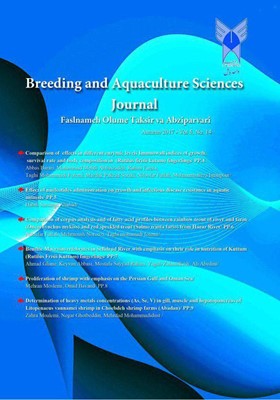اثر سطوح مختلف پری بیوتیک ایمنووال بر شاخصهای رشد، درصد بقاء و ترکیب لاشه بچه ماهی سفید (Rutilus frisii kutum ) دریای خزر
الموضوعات : Breeding and Aquaculture Sciences Journalعباس براری 1 , محمد مهدی عباس زاده 2 , رحیم فرنیا 3 , تقی محمدی فوتمی 4 , مزدک پاکزاد سورکی 5 , نیلوفر فلاح 6 , محمدرضا ایمانپور 7
1 - دانشجوی دکتری شیلات، دانشگاه منابع طبیعی گرگان، گرگان، ایران
2 - دانشجوی دکتری شیلات، واحد بابل، دانشگاه آزاد اسلامی، بابل، ایران
3 - اداره کل شیلات استان مازندران، بابلسر، ایران
4 - دانشجوی دکتری شیلات، واحد بابل، دانشگاه آزاد اسلامی، بابل، ایران
5 - اداره کل شیلات استان مازندران، بابلسر، ایران
6 - دانشجوی دکتری شیلات، واحد بابل، دانشگاه آزاد اسلامی، بابل، ایران
7 - استادگروه تکثیر و پرورش، دانشگاه منابع طبیعی گرگان، گرگان، ایران
الکلمات المفتاحية: بازماندگی, ترکیب لاشه, پری بیوتیک ایمنووال, ماهی سفید(Rutilus frisii kutum),
ملخص المقالة :
در این تحقیق تأثیر پری بیوتیک ایمنووال بر افزایش وزن، ضریب تبدیل غذایی، ضریب رشد ویژه، طول کل و درصد بازماندگی بچه ماهیان سفید دریای خزر (Rutilus frisii kutum) مورد بررسی قرار گرفت. به این منظور، تعداد 300 قطعه بچه ماهی سفید در مخازن و نیرو با سه تکرار قرار گرفتند. بچه ماهیان با جیر ه های حاوی مقادیر صفر (گروه شاهد)، 5/0، 1 و 5/1 گرم بر کیلوگرم پری بیوتیک تغذیه شدند. تغذیه بچه ماهیان روزانه دو بار و به مدت 8 هفته با جیره های آزمایشی انجام شد. نتایج به دست آمده از این تحقیق نشان داد استفاده از پری بیوتیک ایمنووال اثرات مثبتی بر شاخص های رشدی مورد بررسی شامل وزن بدن، طول کل، ضریب رشد ویژه داشته و باعث کاهش ضریب تبدیل غذایی وکاهش درصد تلفات در تیمارهای آزمایشی در مقایسه با گروه شاهد گردید. این آزمایش نشان داد که افزایش وزن بدن، ضریب رشد ویژه، ضریب تبدیل غذایی و طول کل در ماهیانی که با جیره حاوی 5/0 گرم پری بیوتیک تغذیه شده بودند در مقایسه با گروه شاهد اختلاف معناداری نداشته .(P>0.05) اما جیره های حاوی 1 و 5/1 گرم پری بیوتیک تغییرات معناداری در رشد ماهیان نسبت به گروه شاهد نشان داد(P<0.05). همچنین درصد بازماندگی نسبت به تیمار شاهد بالاتر بوده است(P<0.05). تیمارهای آزمایشی بر روی کیفیت شیمیایی لاشه در بچه ماهیان سفید اثر معناداری داشت (P<0.05).
Afshar, N. (2002). Scientific guide of nutrition, food input and Aquaticmedicine in Iran. Tehran: Samarang Publication, p 216.
2. AOAC. (2000). Official Methods of Analysis. Association of Official Analytical Chemists, Arlington, VA
3. Fuller, R., (1989). Probiotics in man and animals. Journal Applied Bacteriology, 66, 365-378.
4. Gibson, G.R., Roberfroid, B., (1999). Dietary modulation of the human colonic microbiota: introducing the concept of prebiotics. Journal of Nutrition. 125,1401–1412.
5. Hung, S.S.O; lutes, P.B. and Storebakken , T, (1989). Growth and feed efficiency of whitesturgeon (Acipenser transmontanus) sub yearling at different feeding rates . Aquaculture .vol. 80, 147-153.
6. Irianto, A., Robertson, P.A.W., Austin, B., (2002). The use of probiotics in aquaculture :Recent Research and developments in microbiology. 4, 557-567.
7. Mahious A.S and Frans Ollvier. (2005). Effect of dietery inulin and oligosaccharides as prebiotics for weaning turbot, psetta maxima. Aquaculture international. 25, 37-46.
8. Mohantry, B.R., Kadirvel., S.K., Natarajan, R., Bhaskaran, M., (1996). Effect of probiotic supplementation on growth nitrogen utilization and serum cholestrol in broilrs. Brithish Poulty Science, 37: 395-401
9. Panahi, P. (2001). Biochemistry Basics. Tehran University Publication. P 153, 162-163.
10. Peng, A and Gatlin,S. (2003). The role of probiotics in aquaculture. Veterinary Microbiology, 114, 173–186.
11. Shiekhol Islami, M. (2008). The effect of level 1%, 2% and 3% in Pribiotic Inolin on th growth, survivability and bacterial flora of digestive system of rainbow trout. Msc. Thesis. Marine Science and Technology University of Khoramshahr. P 90.
12. Verschuere, L., Rombout, G., Sorgeloos, P., Verstraete, W., (2000). Probiotic Bacteria as Biological Control Agents in Aquaculture. Microbiology And Molecular Biology Reviews. 64, 655-671.
_||_
Afshar, N. (2002). Scientific guide of nutrition, food input and Aquaticmedicine in Iran. Tehran: Samarang Publication, p 216.
2. AOAC. (2000). Official Methods of Analysis. Association of Official Analytical Chemists, Arlington, VA
3. Fuller, R., (1989). Probiotics in man and animals. Journal Applied Bacteriology, 66, 365-378.
4. Gibson, G.R., Roberfroid, B., (1999). Dietary modulation of the human colonic microbiota: introducing the concept of prebiotics. Journal of Nutrition. 125,1401–1412.
5. Hung, S.S.O; lutes, P.B. and Storebakken , T, (1989). Growth and feed efficiency of whitesturgeon (Acipenser transmontanus) sub yearling at different feeding rates . Aquaculture .vol. 80, 147-153.
6. Irianto, A., Robertson, P.A.W., Austin, B., (2002). The use of probiotics in aquaculture :Recent Research and developments in microbiology. 4, 557-567.
7. Mahious A.S and Frans Ollvier. (2005). Effect of dietery inulin and oligosaccharides as prebiotics for weaning turbot, psetta maxima. Aquaculture international. 25, 37-46.
8. Mohantry, B.R., Kadirvel., S.K., Natarajan, R., Bhaskaran, M., (1996). Effect of probiotic supplementation on growth nitrogen utilization and serum cholestrol in broilrs. Brithish Poulty Science, 37: 395-401
9. Panahi, P. (2001). Biochemistry Basics. Tehran University Publication. P 153, 162-163.
10. Peng, A and Gatlin,S. (2003). The role of probiotics in aquaculture. Veterinary Microbiology, 114, 173–186.
11. Shiekhol Islami, M. (2008). The effect of level 1%, 2% and 3% in Pribiotic Inolin on th growth, survivability and bacterial flora of digestive system of rainbow trout. Msc. Thesis. Marine Science and Technology University of Khoramshahr. P 90.
12. Verschuere, L., Rombout, G., Sorgeloos, P., Verstraete, W., (2000). Probiotic Bacteria as Biological Control Agents in Aquaculture. Microbiology And Molecular Biology Reviews. 64, 655-671.


